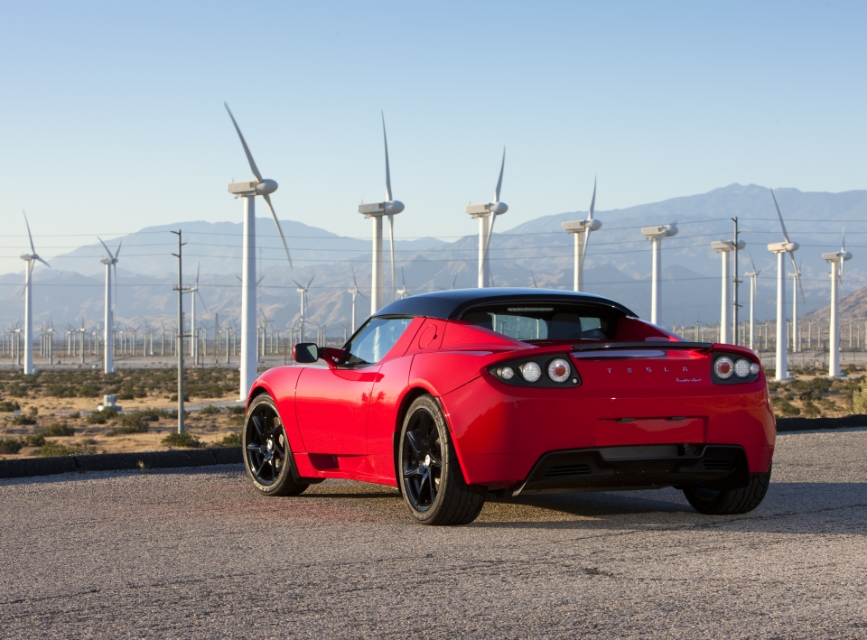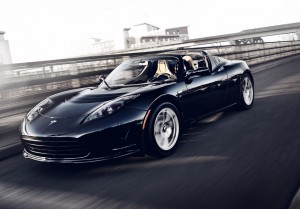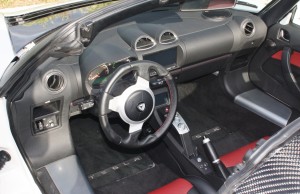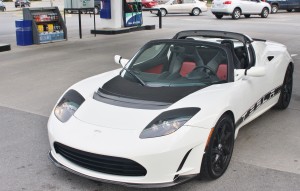
The Tesla Roadster (2008-2012) will soon benefit from an upgrade package that will give it 400 miles of range (Image: Tesla Motors)
Tesla Motors’ first vehicle – the simply-named Roadster – was a ground breaking vehicle when it hit the market in 2008.
Based on a carbon fibre Lotus bodyshell, the all-electric Roadster was a pocket rocket that astounded motorists and auto journalists alike with its neck-snapping acceleration and handling, smashing pre-conceived notions of what an electric car could be.
Tesla hasn’t forgotten that first car, which stopped production in 2012 after the company’s initial order of 2,500 Lotus bodies ran out. On Dec. 26, the company announced an upgrade package for remaining Roadsters, designed to give the vehicles a greatly enhanced range and a new lease on life.

Tesla will demonstrate the Roadster 3.0 Package with a Frisco to L.A. cruise in January (Image: Tesla Motors)
Though they came from the factory with a then-impressive 244-mile (393 kilometre) range, Tesla estimates the improvements included in the ‘Roadster 3.0 Package’ will give the tiny two-seater a 400-mile (644 km) range.
The package, available in spring of 2015, includes a lithium-ion battery pack with a 31% greater capacity than the original, an aerodynamics kit that reduces drag by 15%, low rolling resistance tires, and upgraded front wheel bearings and brakes.
Read more about the upgrades here.
In the first few months of the New Year, Tesla will perform a demonstration run from San Francisco to Los Angeles to highlight the Roadster’s increased range.
An hour in Heaven
In the summer of 2011, I was able to snag an hour of alone time behind the wheel of a Roadster 2.5 Sport, the last version of the model.
The sexy white Roadster was pure motoring bliss, and turned heads wherever it went. I’d have spirited it off into the sunset, except the PR team that handed it too me warned of a $157,000 bill in the mail if anything happened to it.
Given my 6’4″ frame, getting into the Roadster could easily have been accomplished by stepping over the door sill. Once nestled inside, about a millimetre off the ground, I had to crouch a bit to get my head out of the slipstream coming over the windshield.
I was struck by the Roadster’s spartan, user-friendly interior. Gear selection was accomplished via pushbuttons, as was the parking brake, but everything else was as one would expect.
With electric sports cars being a niche oddity at the time (a trend that continues today) the driving experience was surprisingly predictable and familiar. At a stoplight, the car would creep forward when you eased up on the brake pedal, just like any automatic transmission-equipped gasoline-burner.
What wasn’t familiar was the instant burst of acceleration from the rear-mounted 288-horsepower motor. Because the motor didn’t have to worry about things like RPMs or gear ratios, its 295 foot-pounds of torque were instantly available right off the line, seamlessly doled out by a 1-speed Borg-Warner transmission.
When it was first tested by the crew at Top Gear, the resulting review declared the Roadster to be “Biblically quick” – a description that stuck in my mind over the years.
Yes, the Roadster, with its 0-60 time of 3.7 seconds, didn’t accelerate so much as it instantly attained the desired speed. A light jab at the throttle on the highway meant your 80-to-120km/h passing acceleration was accomplished, seemingly, in the blink of an eye.
Tesla’s introduction to the vehicle market in 2008 came like a brick through the plate glass window of established norms. An independent maker of all-electric performance vehicles – in America, no less? Where did this come from?
As the Big Three automakers struggled to stay alive in that tumultuous year, Tesla had provided a glimpse of an alternate future. It also showed what can happen when imagination meets a pile of capital.

